Antitumor Activity of Ruthenium(II) Terpyridine Complexes towards Colon Cancer Cells In Vitro and In Vivo
Abstract
1. Background
2. Results
2.1. Interactions of Ruthenium(II) Terpyridine Complexes Ru-1 and Ru-2 with Glutathione
2.2. Ruthenium(II) Terpyridine Complexes Exerts Cytotoxic Capacity against Colon Carcinoma Cells
2.3. Effects of Ruthenium(II) Terpyridine Complexes on Apoptosis in Human and Murine Colon Carcinoma Cells
2.4. Effects of Ruthenium(II) Terpyridine Complexes on Cells Cycle in Human and Murine Colon Carcinoma Cells
2.5. Ruthenium(II) Terpyridine Complexes Reduce the Tumor Growth In Vivo
2.6. Ruthenium(II) Terpyridine Complexes Are Well Tolerated In Vivo
3. Discussion
4. Materials and Methods
4.1. Cell Lines
4.2. Preparation of Complex Solution
4.3. Cytotoxicity Assays
4.4. MTT Assay
4.5. Lactate Dehydrogenase (LDH) Assay
4.6. Annexin V-Propidium Iodide Double Staining Assay
4.7. Cell Cycle Analysis
4.8. Experimental Animals
4.9. Animal Model and Drug Treatment
4.10. Estimation of Heterotopic Colon Carcinoma Growth
4.11. Toxicity Assessment
4.12. Statistical Analysis
5. Conclusions
Author Contributions
Funding
Acknowledgments
Conflicts of Interest
Abbreviations
| ALT | Alanine aminotransferase |
| AST | Aspartate aminotransferase |
| CO2 | Carbon dioxide |
| CT26 | Mouse colon carcinoma cell line |
| dach | 1,2-diaminocyclohexane |
| DMEM | Dulbecco’s Modified Eagle Medium |
| DMSO | Dimethyl sulfoxide |
| DNA | Deoxyribonucleic acid |
| en | Ethylenediamine |
| FACS | Fluorescence-activated cell sorting |
| FITC | Fluorescein isothiocyanate |
| GSH | Reduced glutathione |
| HCT116 | Human colorectal carcinoma cell line |
| 1H NMR | Proton nuclear magnetic resonance |
| HSA | Human serum albumin |
| IC50 | Half-maximal inhibitory concentration |
| KP1019 | indazolium trans-[tetrachlorobis(1H-indazole) ruthenate(III)] |
| KP1339 | sodium salt of indazolium trans-[tetrachlorobis(1H-indazole) ruthenate(III)] |
| LDH | Lactate dehydrogenase |
| MTT | 3-(4,5-dimethylthiazol-2-yl)-2,5-diphenyltetrazolium bromide |
| NAMI-A | imidazolium trans-[tetrachloro(1H-imidazole)-(S-dimethyl sulphoxide) ruthenate(III)] |
| PBS | Phosphate buffered saline |
| PI | Propidium iodide |
| Ru-1 | [Ru(Cl-tpy)(en)Cl][Cl] |
| Ru-2 | [Ru(Cl-tpy)(dach)Cl][Cl] |
| SD | Standard deviation |
| SW480 | Human Dukes’ type B, colorectal adenocarcinoma cell line |
| TGI | Tumor growth inhibition |
| tpy | Terpyridine |
| TSP | Trimethylsilylpropionic acid |
| γ-l-Glu-l-Cys-Gly | gamma-l-glutamyl-l-cysteinyl-glycine |
References
- Barry, N.P.; Sadler, P.J. Exploration of the medical periodic table: Towards new targets. Chem. Commun. Camb. 2013, 49, 5106–5131. [Google Scholar] [CrossRef] [PubMed]
- Ronconi, L.; Sadler, J.P. Using coordination chemistry to design new medicines. Coord. Chem. Rev. 2007, 251, 1633–1648. [Google Scholar] [CrossRef]
- Trondl, R.; Heffeter, P.; Kowol, C.R.; Jakupec, M.A.; Berger, W.; Keppler, B.K. NKP-1339, the first ruthenium-based anticancer drug on the edge to clinical application. Chem. Sci. 2014, 5, 2925–2932. [Google Scholar] [CrossRef]
- Petrioli, R.; Pascucci, A.; Francini, E.; Marsili, S.; Sciandivasci, A.; Tassi, R.; Civitelli, S.; Tanzini, G.; Lorenzi, M.; Francini, G. Neurotoxicity of FOLFOX-4 as adjuvant treatment for patients with colon and gastric cancer: A randomized study of two different schedules of oxaliplatin. Cancer Chemother. Pharmacol. 2008, 61, 105–111. [Google Scholar] [CrossRef] [PubMed]
- Cersosimo, R.J. Oxaliplatin-associated neuropathy: A review. Ann. Pharmacother. 2005, 39, 128–135. [Google Scholar] [CrossRef]
- Kanaoujiya, R.; Singh, M.; Singh, J.; Srivastava, S. Ruthenium based anticancer compounds and their importance. J. Sci. Res. 2020, 64, 264–268. [Google Scholar] [CrossRef]
- Ang, W.H.; Dyson, P.J. Classical and non-classical ruthenium-based anticancer drugs: Towards targeted chemotherapy. Eur. J. Inorg. Chem. 2006, 20, 4003–4018. [Google Scholar] [CrossRef]
- Alessio, E.; Messori, L. NAMI-A and KP1019/1339, Two Iconic Ruthenium Anticancer Drug Candidates Face-to-Face: A Case Story in Medicinal Inorganic Chemistry. Molecules 2019, 24, 1995. [Google Scholar] [CrossRef]
- Bijelic, A.; Theiner, S.; Keppler, B.K.; Rompel, A. X-ray Structure Analysis of Indazolium trans-[Tetrachlorobis(1H-indazole)ruthenate(III)] (KP1019) Bound to Human Serum Albumin Reveals Two Ruthenium Binding Sites and Provides Insights into the Drug Binding Mechanism. J. Med. Chem. 2016, 59, 5894–5903. [Google Scholar] [CrossRef]
- Rilak, A.; Bratsos, I.; Zangrando, E.; Kljun, J.; Turel, I.; Bugarcic, Z.D.; Alessio, E. New water-soluble ruthenium(II) terpyridine complexes for anticancer activity: Synthesis, characterization, activation kinetics, and interaction with guanine derivatives. Inorg. Chem. 2014, 53, 6113–6126. [Google Scholar] [CrossRef]
- Nisavic, M.; Stoiljkovic, M.; Crnolatac, I.; Milosevic, M.; Rilak, A.; Masnikosa, R. Highly water-soluble ruthenium(II) terpyridine coordination compounds form stable adducts with bloodborne metal transporting proteins. Arab. J. Chem. 2018, 11, 291–304. [Google Scholar] [CrossRef]
- Lazic, D.; Arsenijevic, A.; Puchta, R.; Bugarcic, Z.D.; Rilak, A. DNA binding properties, histidine interaction and cytotoxicity studies of water soluble ruthenium(ii) terpyridine complexes. Dalton Trans. 2016, 45, 4633–4646. [Google Scholar] [CrossRef] [PubMed]
- Rilak Simovic, A.; Masnikosa, R.; Bratsos, I.; Alessio, E. Chemistry and reactivity of ruthenium(II) complexes: DNA/protein binding mode and anticancer activity are related to the complex structure. Coord. Chem. Rev. 2019, 398, 113011. [Google Scholar] [CrossRef]
- Wang, F.; Chen, H.; Parkinson, J.A.; Murdoch Pdel, S.; Sadler, P.J. Reactions of a ruthenium(II) arene antitumor complex with cysteine and methionine. Inorg. Chem. 2002, 41, 4509–4523. [Google Scholar] [CrossRef] [PubMed]
- Wang, F.; Xu, J.; Habtemariam, A.; Bella, J.; Sadler, P.J. Competition between glutathione and guanine for a ruthenium(II) arene anticancer complex: Detection of a sulfenato intermediate. J. Am. Chem. Soc. 2005, 127, 17734–17743. [Google Scholar] [CrossRef] [PubMed]
- Hartinger, C.G.; Jakupec, M.A.; Zorbas-Seifried, S.; Groessl, M.; Egger, A.; Berger, W.; Zorbas, H.; Dyson, P.J.; Keppler, B.K. KP1019, a new redox-active anticancer agent-preclinical development and results of a clinical phase I study in tumor patients. Chem. Biodivers. 2008, 5, 2140–2155. [Google Scholar] [CrossRef]
- Wang, F.; Xu, J.; Wu, K.; Weidt, S.K.; Mackay, C.L.; Langridge-Smith, P.R.R.; Sadler, P.J. Competition between glutathione and DNA oligonucleotides for ruthenium(II) arene anticancer complexes. Dalton Trans. 2013, 42, 3188–3195. [Google Scholar] [CrossRef]
- Canovic, P.; Simovic, A.R.; Radisavljevic, S.; Bratsos, I.; Demitri, N.; Mitrovic, M.; Zelen, I.; Bugarcic, Z.D. Impact of aromaticity on anticancer activity of polypyridyl ruthenium(II) complexes: Synthesis, structure, DNA/protein binding, lipophilicity and anticancer activity. J. Biol. Inorg. Chem. 2017, 22, 1007–1028. [Google Scholar] [CrossRef]
- Liu, S.H.; Zhao, J.H.; Deng, K.K.; Wu, Y.; Zhu, J.W.; Liu, Q.H.; Xu, H.H.; Wu, H.F.; Li, X.Y.; Wang, J.W.; et al. Effect of radiation on cytotoxicity, apoptosis and cell cycle arrest of human osteosarcoma MG-63 induced by a ruthenium(II) complex. Spectrochim. Acta. A Mol. Biomol. Spectrosc. 2015, 140, 202–209. [Google Scholar] [CrossRef]
- Ranieri, G.; Laforgia, M.; Nardulli, P.; Ferraiuolo, S.; Molinari, P.; Marech, I.; Gadaleta, C.D. Oxaliplatin-Based Intra-arterial Chemotherapy in Colo-Rectal Cancer Liver Metastases: A Review from Pharmacology to Clinical Application. Cancers 2019, 11, 141. [Google Scholar] [CrossRef]
- Milutinovic, M.M.; Rilak, A.; Bratsos, I.; Klisuric, O.; Vranes, M.; Gligorijevic, N.; Radulovic, S.; Bugarcic, Z.D. New 4′-(4-chlorophenyl)-2,2′:6′,2″-terpyridine ruthenium(II) complexes: Synthesis, characterization, interaction with DNA/BSA and cytotoxicity studies. J. Inorg. Biochem. 2017, 169, 1–12. [Google Scholar] [CrossRef]
- Maes, M.; Vanhaecke, T.; Cogliati, B.; Yanguas, S.C.; Willebrords, J.; Rogiers, V.; Vinken, M. Measurement of Apoptotic and Necrotic Cell Death in Primary Hepatocyte Cultures. Methods Mol. Biol. 2015, 1250, 349–361. [Google Scholar] [CrossRef]
- Chan, F.K.; Moriwaki, K.; De Rosa, M.J. Detection of necrosis by release of lactate dehydrogenase activity. Methods Mol. Biol. 2013, 979, 65–70. [Google Scholar] [CrossRef]
- Yokoo, S.; Masuda, S.; Yonezawa, A.; Terada, T.; Katsura, T.; Inui, K. Significance of organic cation transporter 3 (SLC22A3) expression for the cytotoxic effect of oxaliplatin in colorectal cancer. Drug Metab. Dispos. 2008, 36, 2299–2306. [Google Scholar] [CrossRef] [PubMed]
- Mallepally, R.R.; Chintakuntla, N.; Putta, V.R.; Nagasuryaprasad, K.; Vuradi, R.K.; Madhuri, P.; Satyanarayana, S.S.; Chitumalla, R.K.; Jang, J.; Penumaka, N.; et al. Synthesis, Spectral Properties and DFT Calculations of new Ruthenium (II) Polypyridyl Complexes; DNA Binding Affinity and in Vitro Cytotoxicity Activity. J. Fluoresc. 2017, 27, 1513–1530. [Google Scholar] [CrossRef] [PubMed]
- D’Sousa Costa, C.O.; Araujo Neto, J.H.; Baliza, I.R.S.; Dias, R.B.; Valverde, L.F.; Vidal, M.T.A.; Sales, C.B.S.; Rocha, C.A.G.; Moreira, D.R.M.; Soares, M.B.P.; et al. Novel piplartine-containing ruthenium complexes: Synthesis, cell growth inhibition, apoptosis induction and ROS production on HCT116 cells. Oncotarget 2017, 8, 104367–104392. [Google Scholar] [CrossRef] [PubMed]
- Mühlgassner, G.; Bartel, C.; Schmid, W.F.; Jakupec, M.A.; Arion, V.B.; Keppler, B.K. Biological activity of ruthenium and osmium arene complexes with modified paullones in human cancer cells. J. Inorg. Biochem. 2012, 116, 180–187. [Google Scholar] [CrossRef] [PubMed]
- Florindo, P.R.; Pereira, D.M.; Borralho, P.M.; Rodrigues, C.M.; Piedade, M.F.; Fernandes, A.C. Cyclopentadienyl-ruthenium(II) and iron(II) organometallic compounds with carbohydrate derivative ligands as good colorectal anticancer agents. J. Med. Chem. 2015, 58, 4339–4347. [Google Scholar] [CrossRef]
- Dabiri, Y.; Schmid, A.; Theobald, J.; Blagojevic, B.; Streciwilk, W.; Ott, I.; Wölfl, S.; Cheng, X. A Ruthenium(II) N-Heterocyclic Carbene (NHC) Complex with Naphthalimide Ligand Triggers Apoptosis in Colorectal Cancer Cells via Activating the ROS-p38 MAPK Pathway. Int. J. Mol. Sci. 2018, 19, 3964. [Google Scholar] [CrossRef]
- Bai, J.; Li, Y.; Zhang, G. Cell cycle regulation and anticancer drug discovery. Cancer Biol. Med. 2017, 14, 348–362. [Google Scholar] [CrossRef]
- DiPaola, R.S. To arrest or not to G(2)-M Cell-cycle arrest: Commentary re: A.K. Tyagi et al., Silibinin strongly synergizes human prostate carcinoma DU145 cells to doxorubicin-induced growth inhibition, G(2)-M arrest, and apoptosis. Clin. cancer res., 8: 3512–3519, 2002. Clin. Cancer Res. 2002, 8, 3311–3314. [Google Scholar] [PubMed]
- Wang, Y.; Bian, L.; Chakraborty, T.; Ghosh, T.; Chanda, P.; Roy, S. Construing the Biochemical and Molecular Mechanism Underlying the In Vivo and In Vitro Chemotherapeutic Efficacy of Ruthenium-Baicalein Complex in Colon Cancer. Int. J. Biol. Sci. 2019, 15, 1052–1071. [Google Scholar] [CrossRef] [PubMed]
- Huang, H.L.; Li, Z.Z.; Liang, Z.H.; Yao, J.H.; Liu, Y.J. Synthesis, cellular uptake, apopotosis, cytotoxicity, cell cycle arrest, interaction with DNA and antioxidant activity of ruthenium(II) complexes. Eur. J. Med. Chem. 2011, 46, 3282–3290. [Google Scholar] [CrossRef] [PubMed]
- Tan, S.; Peng, X.; Peng, W.; Zhao, Y.; Wei, Y. Enhancement of oxaliplatin-induced cell apoptosis and tumor suppression by 3-methyladenine in colon cancer. Oncol. Lett. 2015, 9, 2056–2062. [Google Scholar] [CrossRef]
- Lu, X.; Wei, H.; Zhang, X.; Zheng, W.; Chang, C.; Gu, J. Rapamycin synergizes with low-dose oxaliplatin in the HCT116 colon cancer cell line by inducing enhanced apoptosis. Oncol. Lett. 2011, 2, 643–647. [Google Scholar] [CrossRef]
- Kubincová, P.; Novák, J.; Sovadinová, I. Acute Systemic Toxicity: Alternative in Vivo and in Vitro Methods. Chem. Listy 2016, 110, 118–126. [Google Scholar]
- Morris-Stiff, G.; Tan, Y.M.; Vauthey, J.N. Hepatic complications following preoperative chemotherapy with oxaliplatin or irinotecan for hepatic colorectal metastases. Eur. J. Surg. Oncol. 2008, 34, 609–614. [Google Scholar] [CrossRef]
- Hu, Y.; Yu, T.; Liu, X.; He, Y.; Deng, L.; Guo, J.; Hua, Y.; Luo, T.; Gao, X. Improved anti-tumor efficacy via combination of oxaliplatin and fibrin glue in colorectal cancer. Oncotarget 2017, 9, 2515–2526. [Google Scholar] [CrossRef]
- Magnarin, M.; Bergamo, A.; Carotenuto, M.E.; Zorzet, S.; Sava, G. Increase of tumour infiltrating lymphocytes in mice treated with antimetastatic doses of NAMI-A. Anticancer Res. 2000, 20, 2939–2944. [Google Scholar]
- Sava, G.; Bergamo, A.; Zorzet, S.; Gava, B.; Casarsa, C.; Cocchietto, M.; Furlani, A.; Scarcia, V.; Serli, B.; Iengo, E.; et al. Influence of chemical stability on the activity of the antimetastasis ruthenium compound NAMI-A. Eur. J. Cancer. 2002, 38, 427–435. [Google Scholar] [CrossRef]
- Keppler, B.K.; Berger, M.R.; Heim, M.E. New tumor-inhibiting metal complexes. Cancer Treat. Rev. 1990, 17, 261–277. [Google Scholar] [CrossRef]
- Institute of Medicine (US) Committee. Resource Sharing in Biomedical Research; The American Type Culture Collection; Berns, K.I., Bond, E.C., Manning, F.J., Eds.; National Academies Press (US): Washington, DC, USA, 1996; Volume 2. Available online: https://www.ncbi.nlm.nih.gov/books/NBK209072/ (accessed on 28 August 2020).
- Gerlier, D.; Thomasset, N. Use of MTT colorimetric assay to measure cell activation. J. Immunol. Methods 1986, 94, 57–63. [Google Scholar] [CrossRef]
- Mosmann, T. Rapid colorimetric assay for cellular growth and survival: Application to proliferation and cytotoxicity assays. J. Immunol. Methods 1983, 65, 55–63. [Google Scholar] [CrossRef]
- Shounan, Y.; Feng, X.; O’Connell, P.J. Apoptosis detection by annexin V binding: A novel method for the quantitation of cell-mediated cytotoxicity. J. Immunol. Methods 1998, 217, 61–70. [Google Scholar] [CrossRef]
- Tang, B.; Wan, D.; Lai, S.H.; Yang, H.H.; Zhang, C.; Wang, X.Z.; Zeng, C.C.; Liu, Y.J. Design, synthesis and evaluation of anticancer activity of ruthenium (II) polypyridyl complexes. J. Inorg. Biochem. 2017, 173, 93–104. [Google Scholar] [CrossRef]
- Sato, N.; Michaelides, M.C.; Wallack, M.K. Characterization of tumorigenicity, mortality, metastasis, and splenomegaly of two cultured murine colon lines. Cancer Res. 1981, 41, 2267–2272. [Google Scholar]
Sample Availability: All data and materials are fully available and are shown within the manuscript. | |
Publisher’s Note: MDPI stays neutral with regard to jurisdictional claims in published maps and institutional affiliations. |

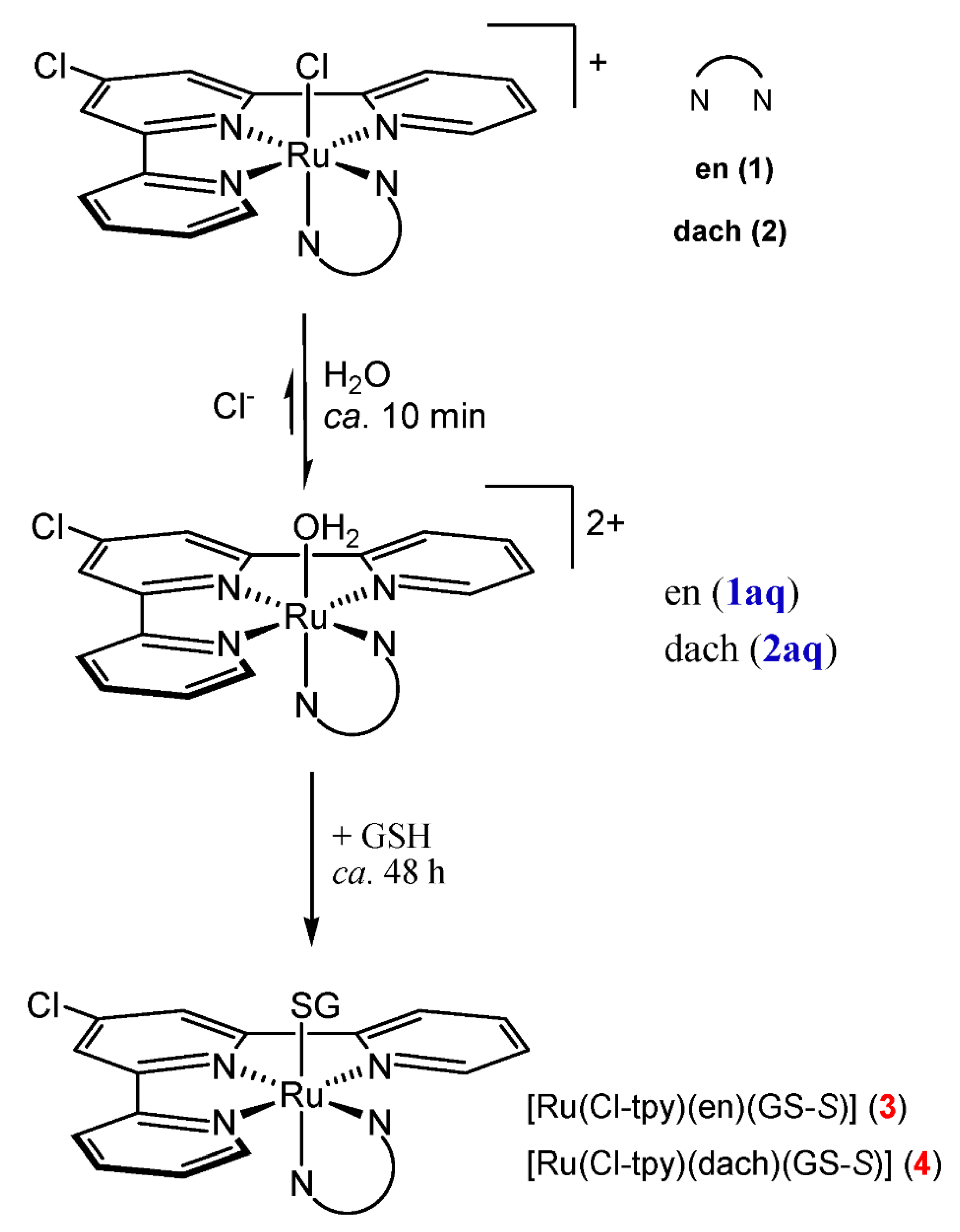



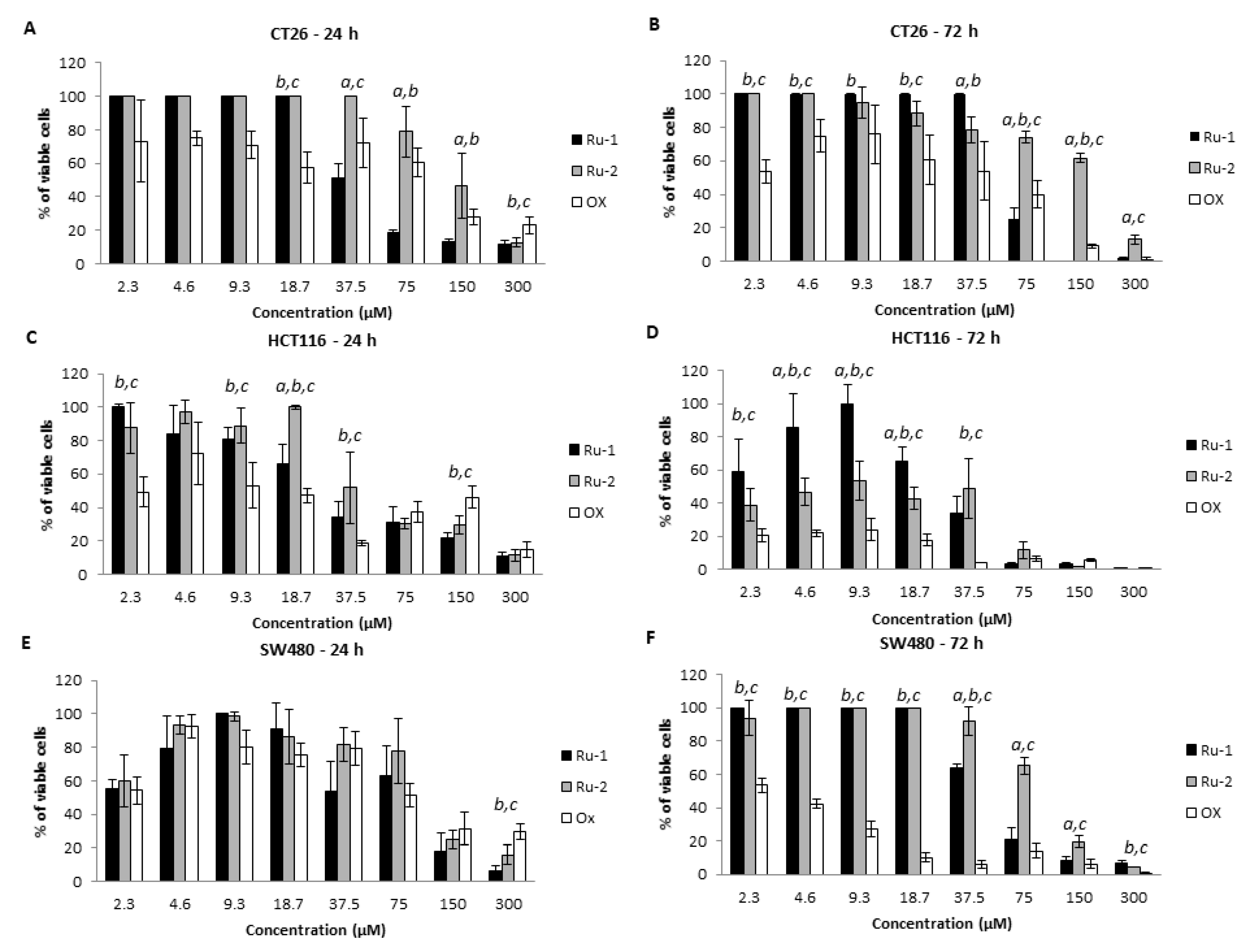
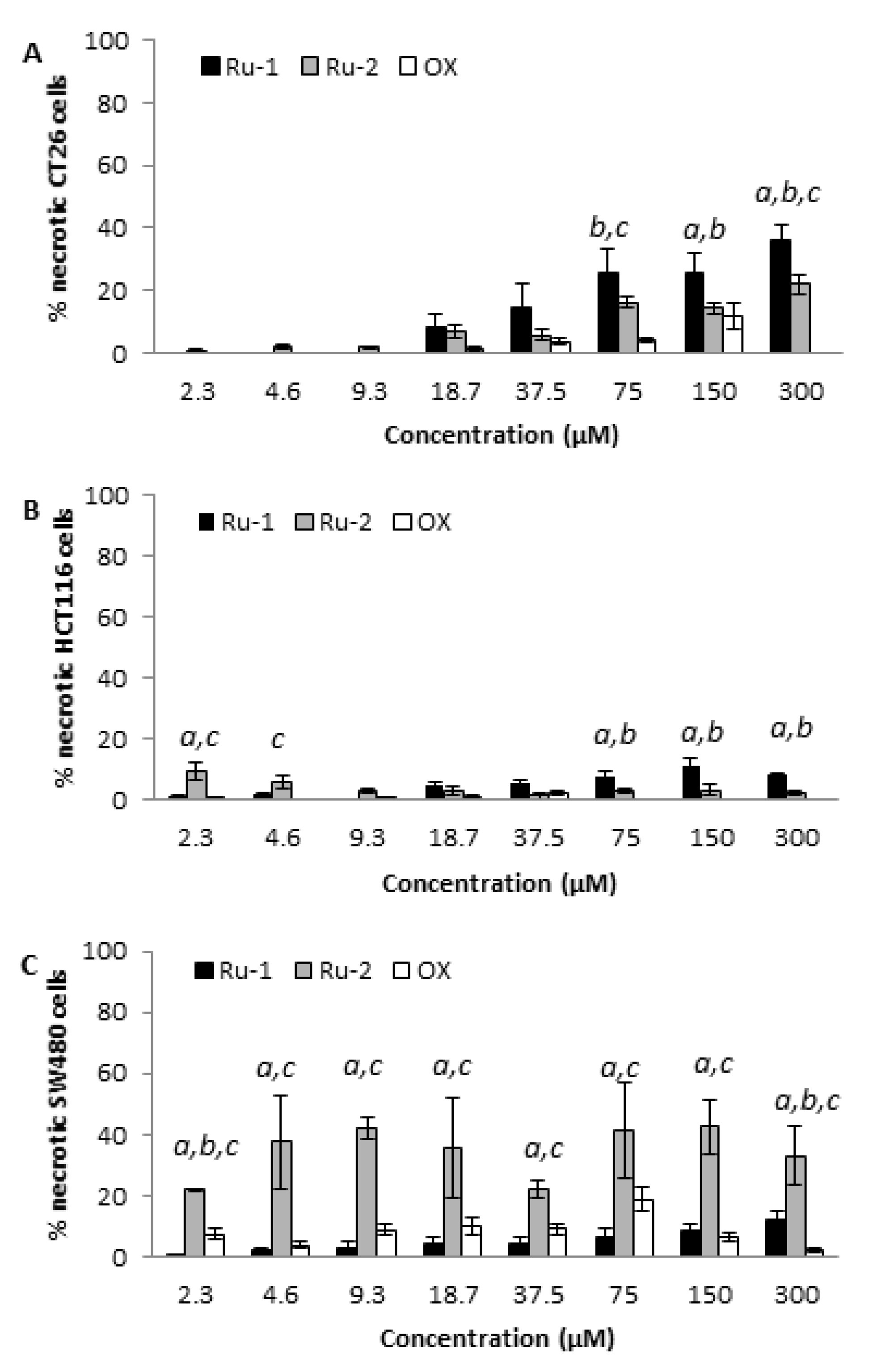
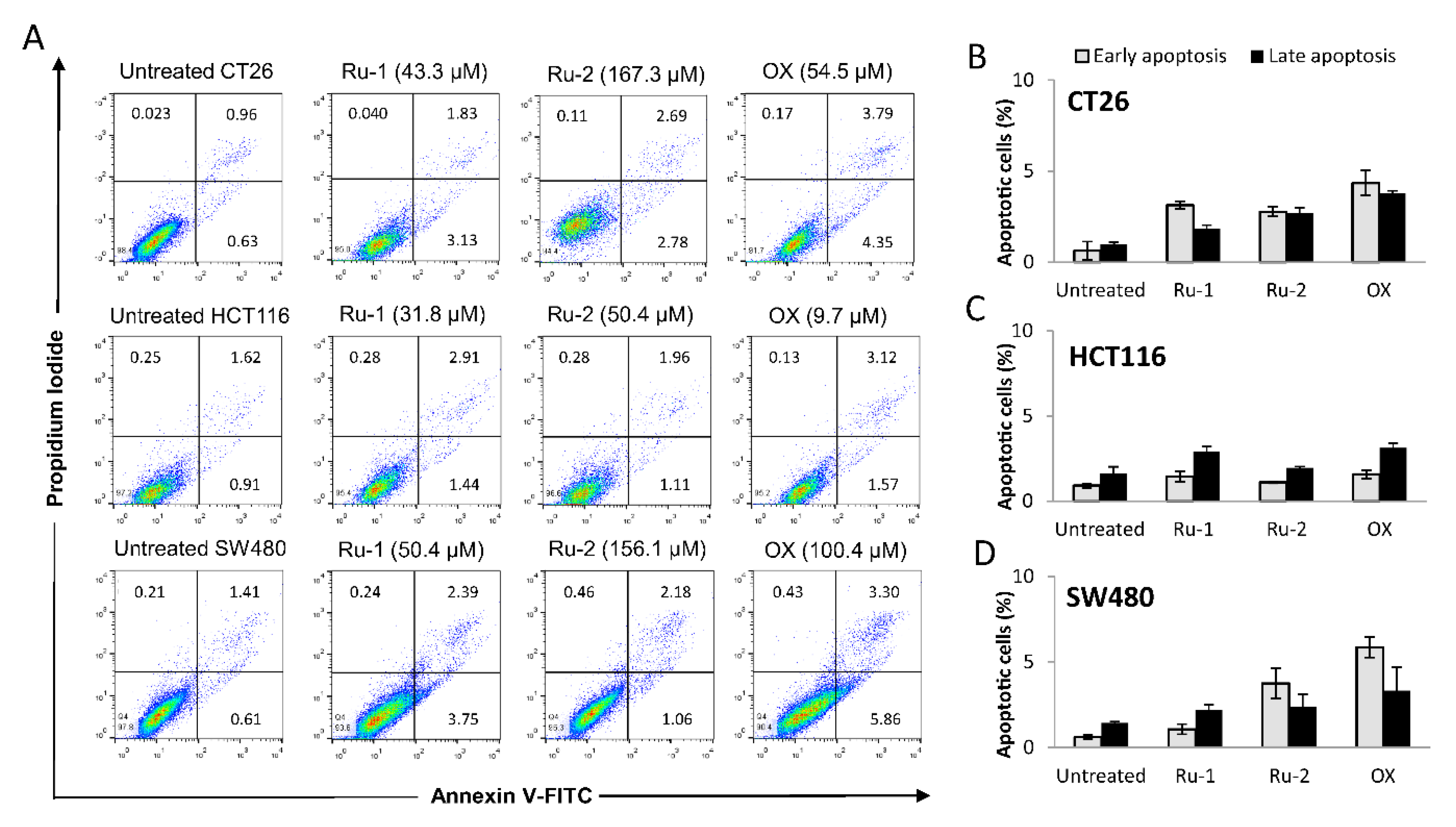

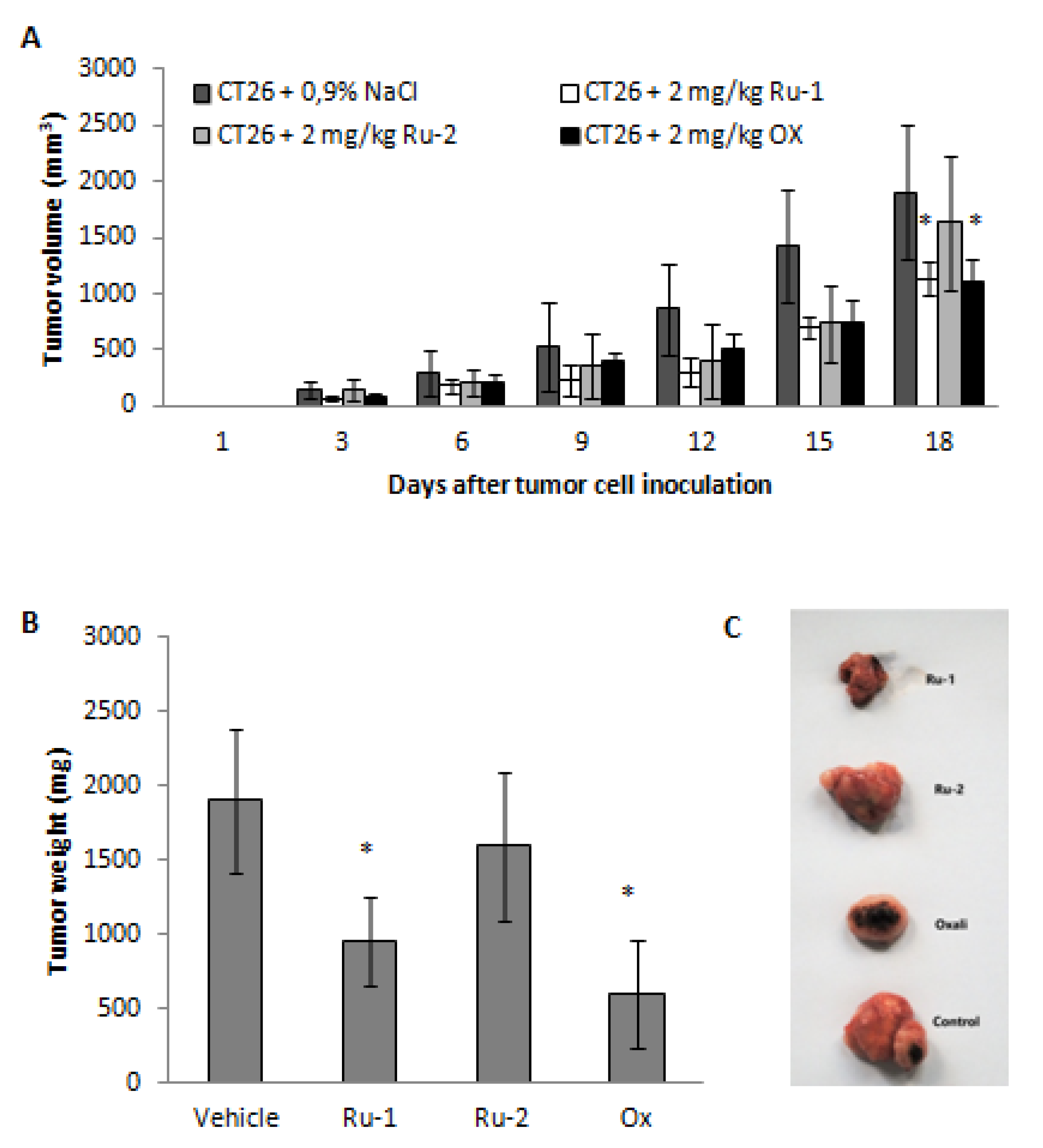
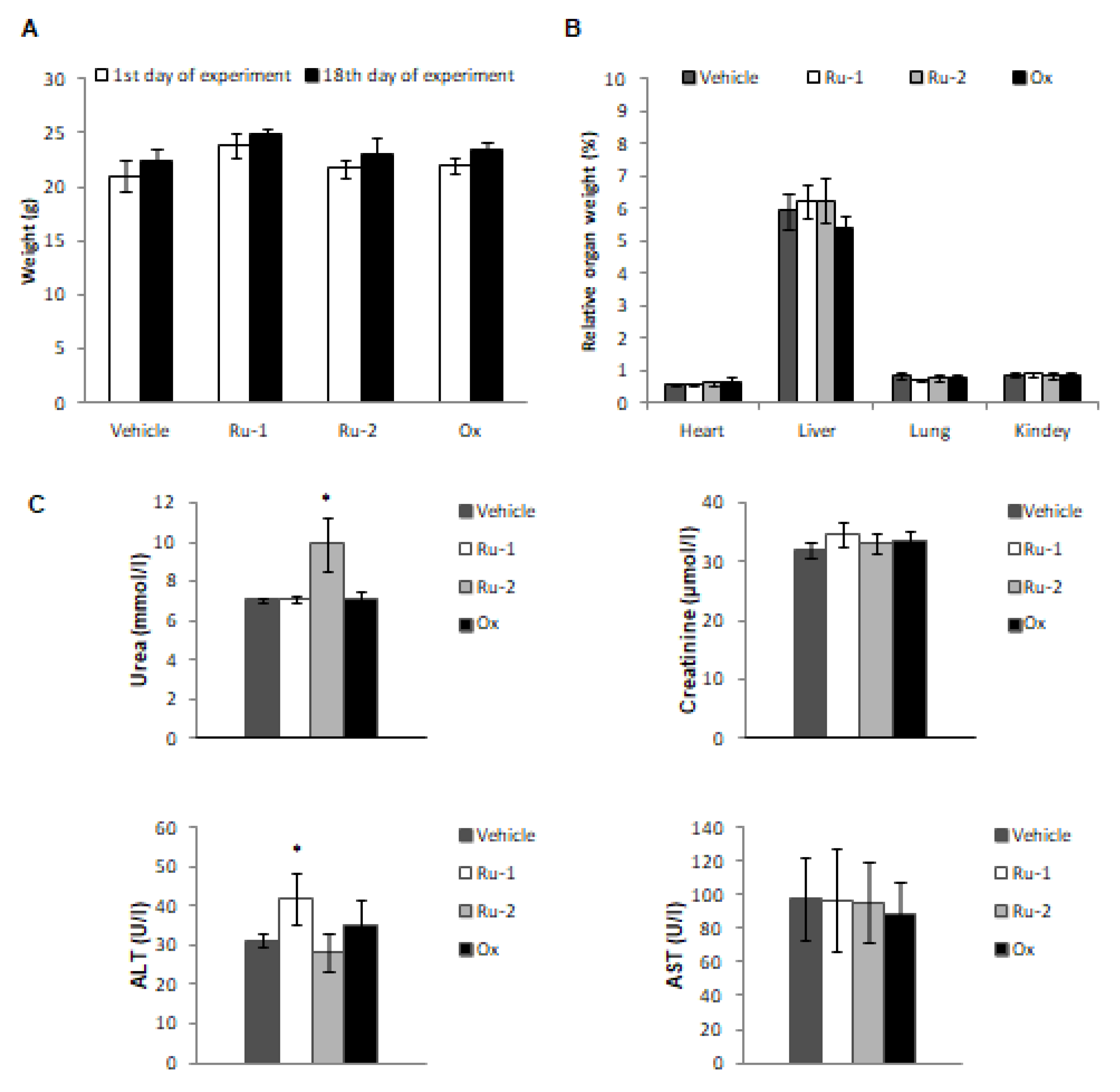

| Complex | IC50 ± SD (μM) | |||||
|---|---|---|---|---|---|---|
| CT26 | HCT116 | SW480 | ||||
| 24 h | 72 h | 24 h | 72 h | 24 h | 72 h | |
| Ru-1 | 43.3 ± 3 | 50.9 ± 4 | 31.8 ± 2 | 19.1 ± 1 | 50.4 ± 4 | 44.7 ± 4 |
| Ru-2 | 167.3 ± 12 | 148.4 ± 11 | 50.4 ± 5 | 20.4 ± 1 | 156.1 ± 12 | 86.4 ± 7 |
| Oxaliplatin | 54.5 ± 4 | 25.2 ± 2 | 9.7 ± 8 | 0.1 ± 0 | 100.4 ± 9 | 1.3 ± 0 |
© 2020 by the authors. Licensee MDPI, Basel, Switzerland. This article is an open access article distributed under the terms and conditions of the Creative Commons Attribution (CC BY) license (http://creativecommons.org/licenses/by/4.0/).
Share and Cite
Savic, M.; Arsenijevic, A.; Milovanovic, J.; Stojanovic, B.; Stankovic, V.; Rilak Simovic, A.; Lazic, D.; Arsenijevic, N.; Milovanovic, M. Antitumor Activity of Ruthenium(II) Terpyridine Complexes towards Colon Cancer Cells In Vitro and In Vivo. Molecules 2020, 25, 4699. https://doi.org/10.3390/molecules25204699
Savic M, Arsenijevic A, Milovanovic J, Stojanovic B, Stankovic V, Rilak Simovic A, Lazic D, Arsenijevic N, Milovanovic M. Antitumor Activity of Ruthenium(II) Terpyridine Complexes towards Colon Cancer Cells In Vitro and In Vivo. Molecules. 2020; 25(20):4699. https://doi.org/10.3390/molecules25204699
Chicago/Turabian StyleSavic, Maja, Aleksandar Arsenijevic, Jelena Milovanovic, Bojana Stojanovic, Vesna Stankovic, Ana Rilak Simovic, Dejan Lazic, Nebojsa Arsenijevic, and Marija Milovanovic. 2020. "Antitumor Activity of Ruthenium(II) Terpyridine Complexes towards Colon Cancer Cells In Vitro and In Vivo" Molecules 25, no. 20: 4699. https://doi.org/10.3390/molecules25204699
APA StyleSavic, M., Arsenijevic, A., Milovanovic, J., Stojanovic, B., Stankovic, V., Rilak Simovic, A., Lazic, D., Arsenijevic, N., & Milovanovic, M. (2020). Antitumor Activity of Ruthenium(II) Terpyridine Complexes towards Colon Cancer Cells In Vitro and In Vivo. Molecules, 25(20), 4699. https://doi.org/10.3390/molecules25204699







